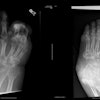Using a 75% threshold, Japanese and U.S. investigators found that 64-slice multidetector-row CT (MDCT) could accurately diagnose coronary artery stenosis, according to a presentation at the 2007 American College of Cardiology (ACC) meeting in New Orleans.
"Almost all studies of MDCT have used 50% stenosis as the standard for calculating diagnostic accuracy, even though 75% is considered significant in clinical practice," according to principal investigator Dr. Takeshi Kondo of Takase Clinic in Takasaki, Japan.
Working with a 75% threshold allowed the team to include people typically excluded from similar studies, such as those with arrhythmias, severe calcifications, and stents. These patients are seen quite often in the clinical setting, the researchers explained.
MDCT turned in high sensitivity, specificity, and positive predictive value (PPV) and negative predictive value (NPV) when compared to conventional coronary angiography, Kondo said, stressing also that larger vessels -- greater than 2 mm in diameter -- are the ones that are "clinically relevant and deserving of intervention."
Their study population consisted of 59 consecutive patients who were scheduled for conventional angiography, which they had after imaging with 64-slice MDCT (Aquilion 64, Toshiba, Japan). Two patients were excluded because they could not manage the breath-hold during the scan.
Among the remaining 57 patients, there were 554 coronary segments larger than 2 mm in diameter. The investigators analyzed these vessels for stenosis that was more than 75%. They also identified 71 segments in which the vessels were smaller than 2 mm. The investigators included any patients with severe calcifications, arrhythmias, tachycardia, or stents, as well as results with motion artifacts.
When compared to conventional coronary angiography, MDCT had a sensitivity of 89% for detecting stenosis of more than 75%. Specificity was 92%, PPV was 67%, and NPV was 98%. In vessels larger than 2 mm, the diagnostic accuracy was over 90% and reached 100% in 4-mm vessels. It was least accurate in vessels that were 1 mm to 2 mm in diameter, Kondo said.
By Paula Moyer
AuntMinnie.com contributing writer
May 9, 2007
Related Reading
Dual-source coronary CTA images the calcium-burdened, May 13, 2007
Calcification percentage higher in stable carotid plaques, March 28, 2007
Copyright © 2007 AuntMinnie.com

















